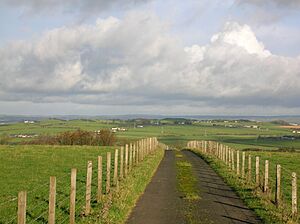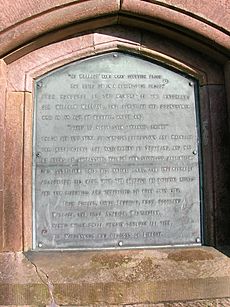Wallace's Monument, Ayrshire facts for kids
Quick facts for kids Wallace's Monument |
|
|---|---|

Wallace's Monument from the entrance gate
|
|
| 55°31′58.9″N 4°31′34.9″W / 55.533028°N 4.526361°W | |
| Location | Craigie, South Ayrshire |
| Country | |
| History | |
| Former name(s) | Barnweil Tower |
| Architecture | |
| Functional status | Closed to the public |
| Heritage designation | Category A listed |
| Architect(s) | Robert Snodgrass from William Dobie's design |
| Architectural type | Tower |
| Style | Gothic |
| Completed | 1857 |
| Specifications | |
| Width | 12 ft (3.7 m) |
| Height | 60 ft (18 m) |
| Materials | Polished sandstone ashlar |
| Administration | |
| Parish | Craigie |
The Wallace's Monument, also known as the Wallace Tower or Barnweil Monument, is a special building in South Ayrshire, Scotland. It stands on Barnweil Hill, a noticeable spot in the area of Craigie. This monument was built to honor the famous Scottish hero, William Wallace. It is a very important building, listed as "category A" in Scotland.
Contents
History of Wallace's Monument
Why and How It Was Built
The Wallace Monument is a beautiful Gothic-style tower. It was built to remember William Wallace during a time when many Scots wanted their country to be independent. This monument was actually built before the more famous Wallace Monument in Stirling, which opened in 1869.
There's a story that the name "Barnweil" comes from Wallace saying the "Barns of Ayr" (where English soldiers were) "burn weil" (burn well). However, this story isn't true. The name actually comes from the old medieval church of Barnweil, which was nearby.
In 1854, people started looking for designs for the monument. William Dobie of Beith designed it, and Mr. Snodgrass built it. The Dobie family were well-off and interested in history. The land for the monument was given by Brigadier-General James George Smith-Neil in 1855.
William Patrick is also said to have helped build the monument. Dobie mentioned that he built the tower himself after trying to get public support for it.
What's in a Name?
The name "Barnweil" has been spelled in different ways over time, like Barnwell and Burnweill. It was first recorded around 1177-1204. The name might come from an old word meaning "tree."
How the Tower Looks
Robert Snodgrass built the tower between 1855 and 1857. It's a square Gothic tower made from smooth sandstone blocks. It's about 12 feet wide at the bottom and 60 feet tall. The top has a fancy wall with pointed decorations.
The tower has different levels marked by stone bands. It also has a special top section with small towers and ball-shaped decorations. The main entrance is a wooden door with a pointed arch. There are also arched spaces on the other sides of the tower.
Above the entrance, you can see the Wallace family's coat of arms and their motto, "Pro Libertate Patriae" (For the Liberty of the Homeland). A local artist named John Logan carved these. Inside, a spiral staircase leads up to a viewing platform.
Messages on the Tower
The tower has special bronze panels with powerful messages about William Wallace.
At the Base of the Tower
On three sides, these panels tell about Wallace's bravery and his struggles:
- Side 1 talks about how the monument was built in 1855 to honor Sir William Wallace, who was born in 1270. It says he was a great hero who fought for Scotland's freedom. It also mentions that he was sadly betrayed and killed in 1305. The message states that his heroic actions will always be remembered and honored.
- Side 2 describes Sir William Wallace as the "Regent of Scotland" in 1297. It explains how he fought bravely against invaders to protect his country's laws and freedom. He won battles like Biggar and Stirling. In just over a year, he took back many forts and towns from the invaders. Even though he lost the Battle of Falkirk, he kept fighting until he was betrayed by Monteith seven years later.
- Side 3 praises Wallace as a matchless hero. It says he was the first Scot to bravely stand up against unfair rule and fight for Scotland's independence. His brave actions and pure love for his country have made Scotland proud. The message compares him to other great heroes like Leonidas from Greece and Washington from America, calling them symbols of liberty forever.
At the Top of the Tower
Carved into the stone at the very top of the tower are the words: "The Barns o' Ayr burn weel"
Around the Monument
The tower is in a circular area with some trees, which are left over from many trees planted there originally.
Near the entrance gate, there used to be a small house where the tower's warden or guide lived. In 1875, a "Visitors' book" showed that over 2,000 people visited the tower between 1857 and 1858. The lodge also displayed interesting pictures, including one of Wallace, and others of Robert Burns and King Robert the Bruce.
Maps show that this lodge was there until the 1970s, but nothing remains of it now. Some believe it was taken down between 1945 and 1947.
From the top of the tower, you can see amazing views of the town of Ayr, Kilmarnock, the Isle of Arran, and the Carrick Hills.
Who Owns It and How to Visit
The people who built the tower didn't set aside money for its upkeep. So, the Ayr Town Council and later the South Ayrshire Council became responsible for it. At first, a guide helped visitors. Later, you could get the key from a nearby farm. Now, the tower is closed to visitors, but there is a road sign to help people find it and see it from the outside. There is no car park.
Images for kids










